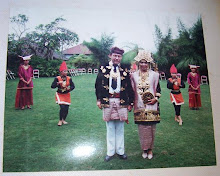Dear all,Today, we are going to understand the topic of food and beverages from Indonesian perspectives.
Why food and beverages link with history, media and technology?
There are at least 3 perspectives in history of food and beverages in Indonesia.
1. Ethnic and cultural background of peopleIndonesia as a nation was only celebrated their freedom some 63 years ago (independence in 1945). Before independence, most Indonesian stick together with their ethnic groups. The Acehnese stayed in Aceh and struggle for their independence, the Bataknese as well but some Bugisness (from Celebes) and Minangkabaunese (from West Sumatera) have been famous for their ability to travel and settle in other places. They call themselves as "ORANG RANTAU". As the consequences of Minang travellers, the Minang food are widely familiar in the archipelago, RUMAH MAKAN PADANG or WARUNG PADANG or the chick RESTAURANT PADANG is available from the very east (Papua) to the North-west of Aceh (Nangroe Aceh Darrusallam). These kind of people are making acceptable and palatable food with strong spices and coconut milk as the base for almost every single food accompany the rice.
Since independence, the Javanese rules Indonesia with their philosophical conotation of UNITY in DIVERSITY or translated as BHINEKA TUNGGAL IKA. The New Order era under Suharto presidency have made many Javanese went and settled in the TRANSMIGRASI area means they settled in a newly opened land outside Java. This makes their food are more popular such as Yogyakartanese may open a restaurant of Gudeg Yogya (Jackfruits in curry) and other transmigrants have made melting pot areas as well contribute to the sociology of food in Indonesia.
Indonesia is diversed in term of ethnic groups. There are at least 13.000 ethnicities in Indonesia. Every ethnic group has their unique cultural, custom and ability to gather food. Some of them are drinking alcoholic beverages some are not. It is too simple to classify food and beverage in term of ethnic groups of Indonesian people. However, Acehnese, Malay origins (Medan, Jambi, Sumatera Barat, Palembang, Lampung), Javanese, Sundanese, Maduranese, Balinese, Bugisnese, Dayaknese, Timornese and Papuanese are among famous ethnic groups in Indonesia.
Let us preview how Malay ethnic groups eat in their special occasion:
Malay Deli (originally from Medan)
- Roti Jala (other staple food are plain rice, Biriani type of rice and casava)
- Lamb Curry
- Kerupuk means Chips made by rice or gloutinous rice powder
- Sambal Goreng (chilli paste mixed liver, prawn, veggies or even peanuts with small fish)
- Some other food accompaniments such as pickles, slices of tomatoes and cucumber.
Minangkabaunese (originally from West Sumatra)
- Plain rice
- Beef Rendang
- Gulai Pucuk Ubi/daun singkong
- Telor Balado
- Sambal Lado Hijau
- Other food accompaniments
They used to have many plates to serve many different kind of food that carried out by hands of a man (two hands can carry 22 plates all together that they call it "MAKAN BAJAMBA").
Now, how do Javanese people (from Central Java, Yogyakarta, Solo and East Java) eat in their special occasion:
- Tumpeng (yellow rice moulded in a curved cilinder form)
- Fried Chicken
- Sambal Goreng
- Urap (mixed veggies with gratted young coconut)
- Tempe Bacem
- Tahu Bacem
- Kerupuk
- Sambal Bajak
2. Geographical perspectives
From geographical perspectives, the islands of Indonesia consist of big islands and many small islands. The biggest island is Kalimantan with their Dayaknese people and has the border with Borneo and Brunei Darrul Salam. There are also other islands which give more geo-political areas such as Sumatra, Java, Nusa Tenggara Barat/NTB, Nusa Tenggara Timur/NTT, Sulawesi and Papua. Small islands near above mentioned geo-political areas can be seen in term of their food culture such as Nias in Sumatera has a unique food as they gather food from the sea and also from the in-land crops. Also Bali, a small island near Java. It has a unique mixture of Hindu Shiwa which is different with Hindu in India. In Bali people eat pork and also cow beef while in India, these kind of flesh are either unfamiliar or/and prohibited to eat.
Let us also see the different perspectives from in-land and sea-shore food culture. We already capture those islands of Indonesia, but we need to also explore more their different habit in food and beverage consumptions.
In-land people and their food and beverage consumption
Most of in-land people are cultured by their cohesion within nature and change. Why?
In-land people usually called themselves as ORANG GUNUNG. Means that they are coming from the mountain. In West Sumatera where Minangkabaunese live, many In-land people reluctant to be called "orang Padang", because "orang Padang" have the connotation from sea-shore where they can be seen as rough, aggresive and use the tricts to manipulate for financial reasons. The area of Padang is sea-shore and people manage to get many experience from the harbour and trading, so that the trickiness becoming their labels. While other areas In-land West Sumatera such as Bukittinggi has been proven to cultivate more intellectuals, ulamas and thinkers. The Minangkabau In-land people can be felt un-easy to get the label of "orang Padang" as they feel that they are not those kinds of sea-shore people.
These kind of ethnology explanations are widely spread across archipelago. In Bali for instance, some In-land people called themselves as Bali Mula or Bali Aga. They see themselves as more democratics and do not practice "Caste" or "Triwangsa or Catur Warna" system.
